The Intel Core i9-9980XE CPU Review: Refresh Until it Hertz
by Ian Cutress on November 13, 2018 9:00 AM ESTHEDT Performance: Web and Legacy Tests
While more the focus of low-end and small form factor systems, web-based benchmarks are notoriously difficult to standardize. Modern web browsers are frequently updated, with no recourse to disable those updates, and as such there is difficulty in keeping a common platform. The fast paced nature of browser development means that version numbers (and performance) can change from week to week. Despite this, web tests are often a good measure of user experience: a lot of what most office work is today revolves around web applications, particularly email and office apps, but also interfaces and development environments. Our web tests include some of the industry standard tests, as well as a few popular but older tests.
We have also included our legacy benchmarks in this section, representing a stack of older code for popular benchmarks.
All of our benchmark results can also be found in our benchmark engine, Bench.
WebXPRT 3: Modern Real-World Web Tasks, including AI
The company behind the XPRT test suites, Principled Technologies, has recently released the latest web-test, and rather than attach a year to the name have just called it ‘3’. This latest test (as we started the suite) has built upon and developed the ethos of previous tests: user interaction, office compute, graph generation, list sorting, HTML5, image manipulation, and even goes as far as some AI testing.
For our benchmark, we run the standard test which goes through the benchmark list seven times and provides a final result. We run this standard test four times, and take an average.
Users can access the WebXPRT test at http://principledtechnologies.com/benchmarkxprt/webxprt/
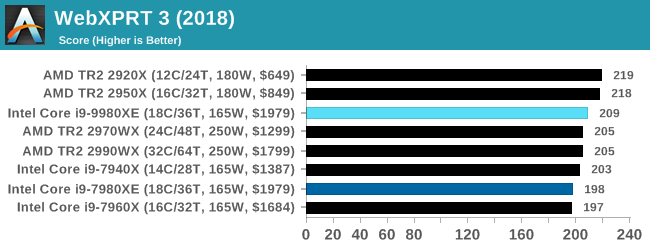
WebXPRT 2015: HTML5 and Javascript Web UX Testing
The older version of WebXPRT is the 2015 edition, which focuses on a slightly different set of web technologies and frameworks that are in use today. This is still a relevant test, especially for users interacting with not-the-latest web applications in the market, of which there are a lot. Web framework development is often very quick but with high turnover, meaning that frameworks are quickly developed, built-upon, used, and then developers move on to the next, and adjusting an application to a new framework is a difficult arduous task, especially with rapid development cycles. This leaves a lot of applications as ‘fixed-in-time’, and relevant to user experience for many years.
Similar to WebXPRT3, the main benchmark is a sectional run repeated seven times, with a final score. We repeat the whole thing four times, and average those final scores.
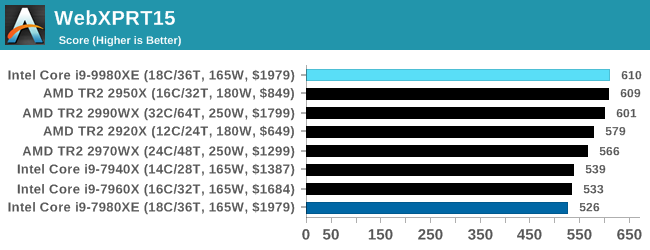
Speedometer 2: JavaScript Frameworks
Our newest web test is Speedometer 2, which is a accrued test over a series of javascript frameworks to do three simple things: built a list, enable each item in the list, and remove the list. All the frameworks implement the same visual cues, but obviously apply them from different coding angles.
Our test goes through the list of frameworks, and produces a final score indicative of ‘rpm’, one of the benchmarks internal metrics. We report this final score.
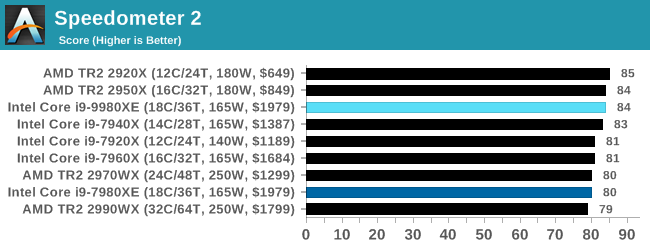
Google Octane 2.0: Core Web Compute
A popular web test for several years, but now no longer being updated, is Octane, developed by Google. Version 2.0 of the test performs the best part of two-dozen compute related tasks, such as regular expressions, cryptography, ray tracing, emulation, and Navier-Stokes physics calculations.
The test gives each sub-test a score and produces a geometric mean of the set as a final result. We run the full benchmark four times, and average the final results.
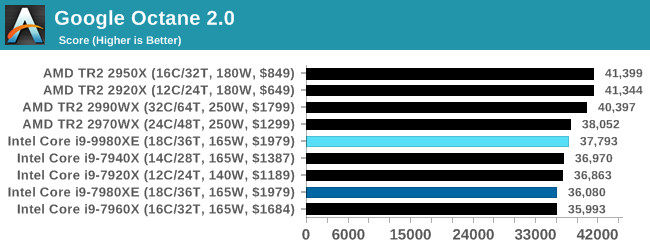
Mozilla Kraken 1.1: Core Web Compute
Even older than Octane is Kraken, this time developed by Mozilla. This is an older test that does similar computational mechanics, such as audio processing or image filtering. Kraken seems to produce a highly variable result depending on the browser version, as it is a test that is keenly optimized for.
The main benchmark runs through each of the sub-tests ten times and produces an average time to completion for each loop, given in milliseconds. We run the full benchmark four times and take an average of the time taken.

3DPM v1: Naïve Code Variant of 3DPM v2.1
The first legacy test in the suite is the first version of our 3DPM benchmark. This is the ultimate naïve version of the code, as if it was written by scientist with no knowledge of how computer hardware, compilers, or optimization works (which in fact, it was at the start). This represents a large body of scientific simulation out in the wild, where getting the answer is more important than it being fast (getting a result in 4 days is acceptable if it’s correct, rather than sending someone away for a year to learn to code and getting the result in 5 minutes).
In this version, the only real optimization was in the compiler flags (-O2, -fp:fast), compiling it in release mode, and enabling OpenMP in the main compute loops. The loops were not configured for function size, and one of the key slowdowns is false sharing in the cache. It also has long dependency chains based on the random number generation, which leads to relatively poor performance on specific compute microarchitectures.
3DPM v1 can be downloaded with our 3DPM v2 code here: 3DPMv2.1.rar (13.0 MB)
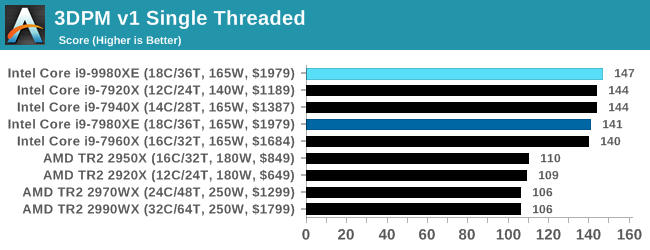
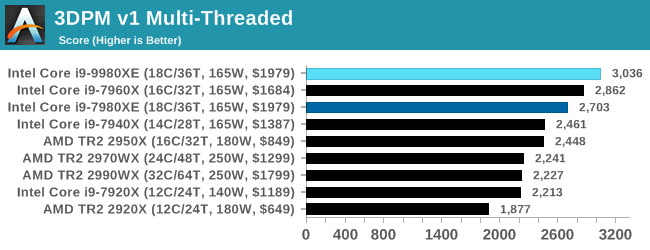
x264 HD 3.0: Older Transcode Test
This transcoding test is super old, and was used by Anand back in the day of Pentium 4 and Athlon II processors. Here a standardized 720p video is transcoded with a two-pass conversion, with the benchmark showing the frames-per-second of each pass. This benchmark is single-threaded, and between some micro-architectures we seem to actually hit an instructions-per-clock wall.
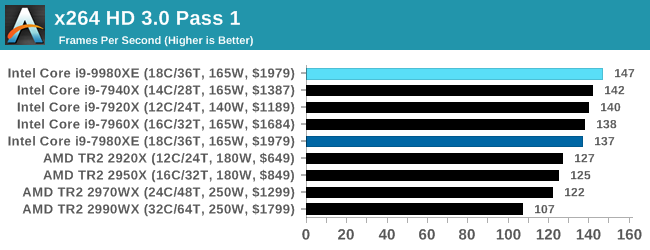
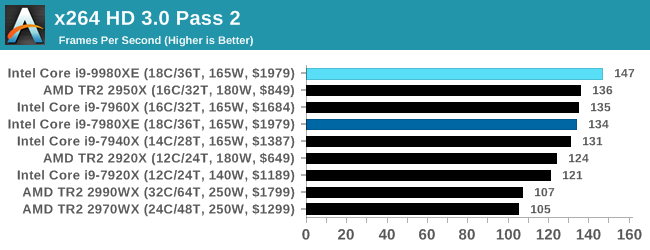










143 Comments
View All Comments
TEAMSWITCHER - Tuesday, November 13, 2018 - link
I never said that we didn't have external monitors, keyboards, and mice for desktop work. However, from 25 years of personal experience in this industry I can tell you emphatically .. productivity isn't related to the number of pixels on your display.HStewart - Tuesday, November 13, 2018 - link
Exactly - I work with 15 in IBM Thinkpad 530 that screen is never used - but I have 2 24in 1980p monitors on my desk at home - if I need to go home office - hook it up another monitor - always with external monitor.It is really not the number of pixels but size of work sapace. I have 4k Dell XPS 15 2in1 and I barely use the 4k on laptop - I mostly use it hook to LG 38U88 Ultrawide. I have option to go to 4k on laptop screen but in reality - I don't need it.
Atari2600 - Tuesday, November 13, 2018 - link
I'd agree if you are talking about going from 15" 1080p laptop screen to 15" 4k laptop screen.But, if you don't see significant changes in going from a single laptop screen to a 40" 4k or even just dual SD monitors - any arrangement that lets you put up multiple information streams at once, whatever you are doing isn't very complicated.
twtech - Thursday, November 15, 2018 - link
Maybe not necessarily the number of pixels. I don't think you'd be a whole lot more productive with a 4k screen than a 2k screen. But screen area on the other hand does matter.From simple things like being able to have the .cpp, the .h, and some other relevant code file all open at the same time without needing to switch windows, to doing 3-way merges, even just being able to see the progress of your compile while you check your email. Why wouldn't you want to have more screen space?
If you're going to sit at a desk anyway, and you're going to be paid pretty well - which most developers are - why sacrifice even 20, 10, even 5% productivity if you don't have to? And personally I think it's at the higher end of that scale - at least 20%. Every time I don't have to lose my train of thought because I'm fiddling with Visual Studio tabs - that matters.
Kilnk - Tuesday, November 13, 2018 - link
You're assuming that everyone who needs to use a computer for work needs power and dual monitors. That just isn't the case. The only person kidding themselves here is you.PeachNCream - Tuesday, November 13, 2018 - link
Resolution and the presence or absence of a second screen are things that are not directly linked to increased productivity in all situations. There are a few workflows that might benefit, but a second screen or a specific resolution, 4k for instance versus 1080, doesn't automatically make a workplace "serious" or...well whatever the opposite of serious is in the context in which you're using it.steven4570 - Tuesday, November 13, 2018 - link
"I wouldn't call them very "professional" when they are sacrificing 50+% productivity for mobility."This is quite honestly, a very stupid statement without any real practical views in the real world.
Atari2600 - Wednesday, November 14, 2018 - link
Not really.The idiocy is thinking that working off a laptop screen is you being as productive as you can be.
The threshold for seeing tangible benefiting from more visible workspace (when so restricted) is very low.
I can accept if folks say they dock their laptops and work on large/multiple monitors - but absolutely do not accept the premise that working off the laptop screen should be considered effective working. If you believe otherwise, you've either never worked with multiple/large screens or simply aren't working fast enough or on something complicated enough to have a worthwhile opinion in the matter! [IMO it really is that stark and it boils my piss seeing folks grappling with 2x crap 20" screens in engineering workplaces and their managers squeezing to make them more productive and not seeing the problem right in front of them.]
jospoortvliet - Thursday, November 15, 2018 - link
Dude it depends entirely on what you are doing. A writer (from books to marketing) needs nothing beyond a 11" screen... I'm in marketing in a startup and for half my tasks my laptop is fine, writing in particular. And yes as soon as I need to work on a web page or graphics design, I need my two screens and 6 virtual desktops at home.I have my XPS 13 for travel and yes I take a productivity hit from the portability, but only when forced to use it for a week. Working from a cafe once or twice a week I simply plan tasks where a laptop screen isn't limiting and people who do such tasks all day (plenty) don't NEED a bigger screen at all.
He'll I know people who do 80% of their work on a freaking PHONE. Sales folks probably NEVER need anything beyond a 15" screen, and that only for 20% of their work...
Atari2600 - Thursday, November 15, 2018 - link
I never said the non-complicated things need anything more than 1 small screen!